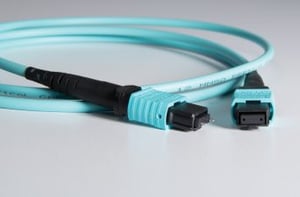 You likely have a budget for your personal life, taking into account the bills you have to pay and the items you want to buy. You typically would start by taking a look at your bank statement to analyze overall cash flow and make sure you are not spending more money than you earn.
You likely have a budget for your personal life, taking into account the bills you have to pay and the items you want to buy. You typically would start by taking a look at your bank statement to analyze overall cash flow and make sure you are not spending more money than you earn.
It's the same philosophy with testing your fiber network. In fact, the terminology is even the same. You work to stay within the "loss budget," and the key to staying within budget is using reliable testing processes and equipment that starts broad and goes deep. Of course, it can seem easier said than done when it comes to testing fiber networks that use parallel optics.
Knowing How to Test Multi-Fiber Connectors - Like MPO - Can Pay Off Big
Parallel optics technology, such as MPO connectors, are rapidly growing in popularity within data center and enterprise fiber networks. This growth brings with it new challenges for both the installation tech and the network operators. First, there is not yet an established, standardized process for testing parallel optics. While codifying the standardized process is a key focus of IEC working groups, it is a lengthy and complicated process, as there are several configurations and other complexities to be covered.
The absence of standards has not stopped the ever-growing use of parallel optics in today's fiber network architectures. This means that the fiber techs who understand how to test architectures that use MPO connectivity will have the most success. Time is money, so ensuring that the network stays up and does not lag, and that the overall system is running within tolerances or budget, is essential.
Typically, the logical place to start would be running a Tier 1 test, which checks length, loss and polarity of the fiber links. But in a troubleshooting scenario, that may not yield enough information to find and fix the problem.
Going from General to Specific: The Types of Tests You Should Run and Why
You need to know what is wrong with your fiber network before you can fix it. To find what is wrong with your fiber network, you can test it. Here's how:
- First, Inspect Before You Connect. Dirty fiber end faces are the top cause of network issues. Unless fiber end faces and ferrules are virtually spotless and defect free, the system will not perform in the way it must. This is especially true for MPO connectors, as they are typically used in higher speed networks and have a higher probability to becoming contaminated. The only way to be sure is to inspect, clean and inspect again.
- Proceed to Tier 1 testing with an Optical Loss Test Set. Tier 1 testing provides overall information for the loss, length and polarity of the fiber links. It shows how strong the signal is from the beginning to the end of the fiber. This is the minimum requirement for fiber network installers to test. It gets right to the point and tells you if your network is meeting the basic requirements or not. It does not, however, identify individual events or faults that need to be fixed. When testing MPO links, it is beneficial to use a test device with native MPO connections directly on the device, as it eliminates time-consuming hassles with breakout cables.
- Follow up with Tier 2 testing using an OTDR. Tier 2 is widely considered to be supplemental to Tier 1, but it also offers a level of insight you cannot get with Tier 1. While Tier 1 provides the overall performance assessment, only Tier 2 shows whether each discrete signal loss is within spec. In other words, it helps isolate where any issue may be. OTDR testing certifies the network as well and is usually a requirement before finishing the job. For network managers, Tier 2 helps you meet internal SLAs and determine whether to upgrade equipment or simply fix what is already there.
The demand for MPO is here, and thankfully, best practices exist and can be applied to just about any network configuration. The key is to eliminate the most likely causes of issues and test your network.
VIAVI offers a wide range of testing and certification solutions. Click here to learn more about VIAVI, and click here to contact your local Accu-Tech representative.



.png?width=58&height=58&name=X_logo_2023_(white).png)
